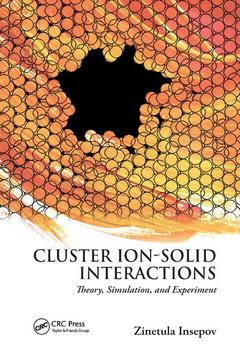Cluster Ion-Solid Interactions Theory, Simulation, and Experiment
Auteur : Insepov Zinetula

Cluster Ion-Solid Interactions: Theory, Simulation, and Experiment provides an overview of various concepts in cluster physics and related topics in physics, including the fundamentals and tools underlying novel cluster ion beam technology. The material is based on the author?s highly regarded courses at Kyoto University, Purdue University, the Moscow Institute of Physics and Technology, and the Moscow Engineering Physics Institute as well as his research results on cluster ion beam applications at Kyoto University.
The author introduces the basic principles of statistical physics and thermodynamics before covering applications, experimental justifications, and practical implementations. He describes classical nucleation theory and explains the drawbacks of this theory, showing how accurate modeling and simulations are necessary to justify theoretical approaches and simplifications.
Introduction. Molecular Models of Cluster Formation. Molecular Dynamics Method. Kinetics of Cluster Formation in Dense Gases. Kinetics of Cluster Formation on Surfaces. Cluster Formation Kinetics in Thin Film Growth. Multiscale Concept for Condensation in Rarefied Gases. Nucleation and Condensation in Gases. Introduction to Advanced Surface Modification with Gas Cluster Ion Beams. Crater Formation by Gas Cluster Ion Beam Impact. Index.
Zinetula Insepov is an adjunct professor in the School of Nuclear Engineering at Purdue University and a professor in the Department of Condensed Matter Physics at the Moscow Engineering Physics Institute (MEPhI). He is the chief scientist and head of the Nanosynergy Laboratory at Nazarbayev University. Dr. Insepov is also a founding faculty fellow of the Skolkovo Institute of Science and Technology (Skoltech)/Massachusetts Institute of Technology (MIT) initiative. He has previously held positions at Albert Ludwig University of Freiburg, Kyoto University, Epion Japan, and Argonne National Laboratory. His research focuses on the fundamental physics of ion beam materials processing, including very-low-energy ion–solid interactions. He developed cluster ion beam interaction simulation programs based on molecular dynamics and Monte Carlo methods. He also predicted a new lateral sputtering phenomenon that is a driving force behind the efficient atomistic smoothening mechanism of surfaces irradiated by large gas cluster ions. Recently, he predicted a nanopumping effect and is developing a new device that allows pump gases and liquids via nanometer-scale channels.
Date de parution : 12-2019
15.6x23.4 cm
Date de parution : 04-2016
15.6x23.4 cm
Thèmes de Cluster Ion-Solid Interactions :
Mots-clés :
Shock Wave Front; Cluster Impact; classical; Cluster Ion; nucleation; MC; theory; GCIB; molecular; MD Method; dynamics; CNT; formation; Cluster Formation; sticking; Cluster Size; coefficient; Gas Cluster; size; Crater Depth; atoms; Crater Formation; Buffer Gas; Total Cluster Energy; Brownian Dynamics; Spinodal Decomposition; Thin Film Growth; MD Calculation; Average Cluster Size; Microcanonical Ensemble; MD Computer Simulation; Energetic Cluster; Adsorbed Atoms; Sputtering Yield; Shock Waves Generated



